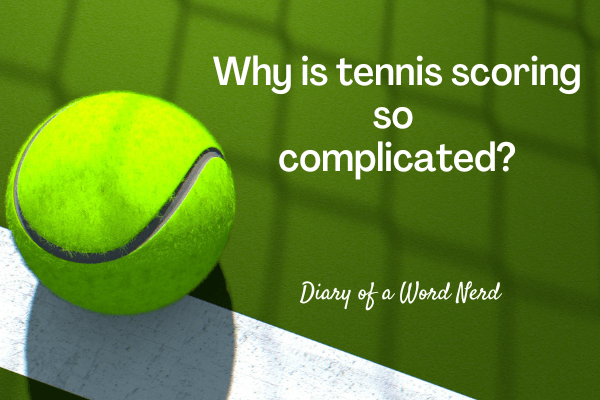One of the things keeping me busy these days (and preventing me from posting sooner in June!) is tennis. Child number four has embraced this as his number one sport, and in an attempt to show motherly support, and because I can’t stand feeling like I don’t understand what is going on, I’m trying to learn all things tennis. I’ve watched more matches in the past three months (thank you, high school tennis season) than I have in the rest of my 51 years. And I’ve already picked up a few things, like what it means to “break” your opponent.
However, there are still many things that confuse me, like what is a “ground stroke” and most pervasively… THE SCORING! Who came up with this confusing system of games, sets, and matches? And why does the scoring jump from intervals of 15 to 10? And why, when you have 0 points, is your score called “love?”
When I asked my son, he didn’t know, so The Word Nerd got down to some research. Here is what I found. (Warning – like most things in life, tennis scoring does not have a well defined explanation.)
The scoring in tennis
I tried to type this up, got confused, and then found the scoring system efficiently and humorously explained at Neilson Active Holidays. Here’s how they put it:
Tennis is played in points: Four points win a game, six games win a set, and two or three sets win a match. You can decide how long you want your game to be but most matches are played as best-of-three or five set contests.
Service stays with one side for the duration of each of those four-point games, which – thanks tennis! – use a numerical sequence and French words that have no relation to actual values.The sequence is:
Neilson Active Holidays
0 points = love
1 point = 15
2 points = 30
3 points = 40
4 points = game
And that’s it!
Thanks again to tennis history you must win a game by at least two points, so if the two sides are drawn at 40 – 40 then “deuce” is called. The winner of the next point is awarded “advantage”, and can then win the game by taking the next point or be brought back to deuce if their opponent scores. There is no limit in the rules to the number of times players can tie at deuce.
Oof. At the region semifinals, my son and his doubles partner went to deuce almost every game. The match took over two hours, but it was very exciting. As you can see, the scoring system is not intuitive or consistent. It’s also hard to follow because, in the case of high school tennis, there is no score board and often you cannot hear or the athletes do not call out the score. I even used a notepad to keep tally marks and still got the score messed up. Surely I will get better at this with time and practice. Luckly, child #4 is just a freshman.
The history of tennis scoring
Where did this crazy system of scoring come from? The short answer: nobody knows.
A longer answer has a bit more information but no more clarity.
Elizabeth Wilson, author of Love Game: A History of Tennis, from Victorian Pastime to Global Phenomenon, told Time.com in 2019, “I don’t think anybody really knows how it started or why it developed how it did.” Wilson says part of what makes the sport romantic and interesting is the history behind it that isn’t really history. More like legend.
Our modern game of tennis probably originated in a game played in 12th century France called “jeu de paume.” Players hit a ball with the palm of the hand until rackets were introduced in the 16th century. The game was very popular among royals and played at court as well as by clergy and commoners. In 16th century Paris, there were more than 1,000 tennis courts in use!
The article “Why is tennis scored so weirdly” from Time.com offers some interesting ideas as to why each point in a game has such a wide variety of values (15, 30, 40…). Some theories include relating points to the minutes that have passed on the clock, the distance between lines on the court, and influence of scoring systems from other games. But no one knows for sure.
Another thing I don’t understand: why is 0 points noted as “love?” Perhaps it came from the similar sounding word l’oeuf from the French, which means egg, which looks like a zero. Or the Dutch/ Flemish word for honor, lof, which would have been used by players relating a tennis match to a battle. Incidentally, “love” has been used since the 18th century to mean nothing in other racket sports as well as some card games, like bridge.
The etiquette surrounding tennis is also (supposed to be) different from other sports. Overall, the matches I attended this spring were much more pleasant than most other high school sporting events I’ve been to. (However, cross country meets remain the most positive sporting enviroments I’ve experienced. 🙂 ) The high school tennis coach encouraged us to stay quiet during the matches and to applaud or cheer only when a player made an exceptionally good shot. It is considered poor form to cheer when a player makes a bad play and loses a point.
Moving forward with tennis
Some people think the odd scoring system keeps an aura of mystery around the game. Some even argue it gives it a certain amount of pomp and formality that separates the tennis fans “in the know” from other sports enthusiasts. Whatever the origins or reasons behind the rules, I am determined to master the scoring system, and perhaps some tennis related skills, so that I can appreciate my son’s play and perhaps hit the ball with him on occasion.
Do you have other questions about tennis, or better yet, some explanations? I’d love to hear them!
Thanks for getting nerdy with me!




